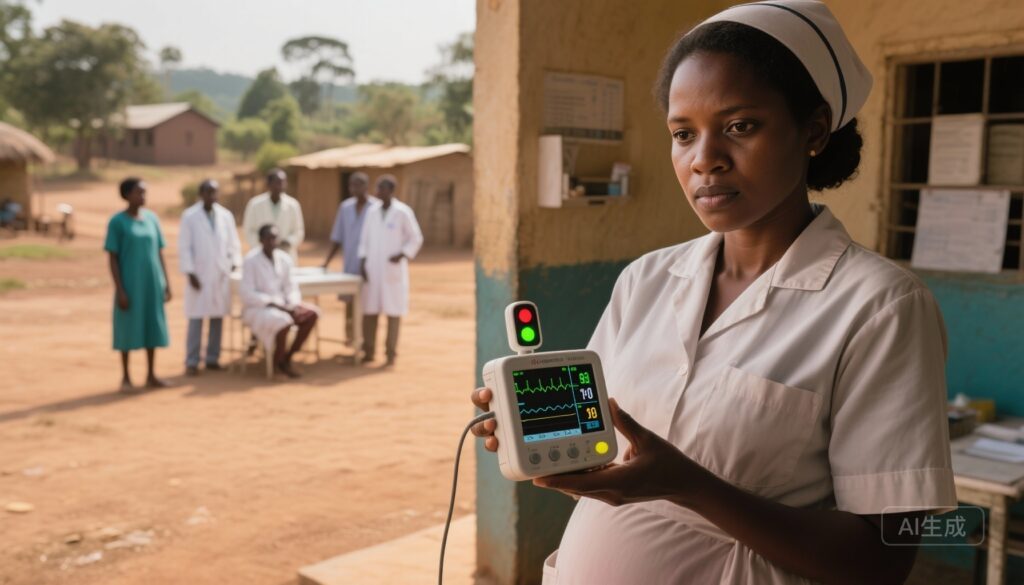Highlight
– National scale-up of the CRADLE Vital Signs Alert (a combined pulse, blood pressure and shock index device with a traffic‑light alert system) in Sierra Leone was feasible and associated with increased frequency and accuracy of vital‑sign measurement in maternity services.
– Despite improved detection and referrals, there was no measurable reduction in a composite clinical outcome (eclampsia, emergency hysterectomy, maternal death, or stillbirth) across 93,811 deliveries (IRR 1.01, 95% CI 0.87–1.16).
– Persistent system‑level constraints (drug and blood shortages, workforce gaps, infrastructure deficits, and limited treatment capacity) likely limited the translation of earlier detection into improved outcomes.
Background
Sierra Leone remains among countries with the highest maternal mortality ratios globally, with haemorrhage, hypertensive disorders (including pre‑eclampsia and eclampsia), and infections contributing the largest share of preventable deaths. Early detection of deterioration using reliable vital‑sign monitoring is a cornerstone of obstetric care, yet many low‑resource facilities lack functioning devices and structured early warning systems. The CRADLE Vital Signs Alert is a simple, robust device designed for low‑resource settings that integrates blood pressure and pulse measurement with a traffic‑light early‑warning display to prompt timely action. Previous pilot and implementation work suggested acceptability and potential to change processes of care, but whether wider scale‑up could reduce hard maternal and perinatal endpoints in routine national services remained uncertain.
Study design
The CRADLE‑5 trial (Ridout et al.) was a pragmatic hybrid type 2 implementation–effectiveness cluster‑randomised trial using a stepped‑wedge design across eight districts in Sierra Leone. Each district (cluster) moved from usual care to the CRADLE intervention in a random sequence, with 6‑week steps, between May 23, 2022, and June 30, 2023. The intervention package comprised distribution of 2,171 CRADLE devices to 643 government health facilities, cascade training delivered by locally appointed CRADLE champions, and integration of the device and alert thresholds into clinical pathways and training curricula. Twenty‑one hundred thirty‑five frontline workers were trained.
The primary clinical endpoint was a composite of eclampsia (seizures related to hypertensive disease), emergency hysterectomy, maternal death, or stillbirth, with events counted without double counting. Implementation outcomes included fidelity (device use), adoption, measurement quality, referral behaviour, and system integration. Analyses used intention‑to‑treat principles and reported incidence risk ratios (IRRs) with 95% confidence intervals adjusted for the stepped‑wedge design and clustering. The trial is registered (ISRCTN 94429427).
Key findings
Population and outcomes: Across the trial period there were 93,811 recorded deliveries — 40,339 pre‑intervention and 53,472 post‑intervention. A total of 1,568 women (1.7%) experienced at least one component of the composite primary outcome: 699 (1.7%) in the pre‑intervention period and 869 (1.6%) post‑intervention. Component counts were 134 vs 205 eclamptic fits, 32 vs 39 emergency hysterectomies, 60 vs 66 maternal deaths, and 551 vs 650 stillbirths in pre‑ and post‑intervention epochs respectively. The primary composite outcome showed no statistically significant change (IRR 1.01, 95% CI 0.87–1.16).
Implementation metrics
– Vital‑sign measurement frequency increased after CRADLE implementation (IRR 1.38, 95% CI 1.07–1.77), indicating improved process adoption.
– Quality of measurement improved: terminal‑digit preference (a common sign of rounding and inaccuracy when recording blood pressure) fell from 32.8% to 8.7% (IRR 0.44, 95% CI 0.25–0.79), suggesting more accurate recordings.
– The intervention strengthened sustainable scale‑up enablers: national leadership support, integration into pre‑service and in‑service training, and community engagement.
Contextual and system findings
Despite better detection and more frequent monitoring, several persistent system‑level barriers were documented that likely limited clinical impact: intermittent availability of essential medications (e.g., magnesium sulfate, antihypertensives), shortages of blood for transfusion, critical workforce gaps (nurse/midwife and clinician shortages), inadequate infrastructure (unreliable electricity, oxygen), and logistical barriers to timely referral and definitive treatment (transport delays, operating theatre availability). The trial authors concluded that while CRADLE could feasibly be scaled nationally and improved certain processes, strengthening the wider health system is required to translate detection into reduced mortality and stillbirths.
Interpretation and critical analysis
The CRADLE‑5 trial provides an instructive example of the limits and opportunities of device‑based, point‑of‑care interventions when scaled across a weak health system. Key points to consider when interpreting the negative primary clinical result despite process improvements include:
1) The difference between detection and treatment
Improved vital‑sign monitoring enables earlier recognition of deterioration, but meaningful reductions in severe outcomes require prompt access to effective treatments (e.g., magnesium sulfate for pre‑eclampsia/eclampsia, uterotonics and blood transfusion for haemorrhage, timely surgery). Where these adjuncts are unavailable or delayed, early warning has limited effect.
2) Choice and sensitivity of endpoints
The composite endpoint combined events with different pathophysiologies and time courses. Some outcomes (e.g., stillbirth) may reflect antenatal insults less amenable to intrapartum vital‑sign detection. Furthermore, the absolute event rate was low (~1.7%), and even with ~94,000 deliveries, the trial may have been underpowered to detect modest relative reductions for specific components.
3) Implementation fidelity and heterogeneity
Although device distribution and training reached many facilities, there may have been variation in fidelity, champion engagement, and local adoption across districts. Stepped‑wedge designs can be affected by secular trends and between‑cluster heterogeneity that attenuate apparent effects.
4) Timeframe for effect
A health‑systems intervention may require longer than the trial window to change staffing, supply chains, referral networks and clinical outcomes. The stepped‑wedge transitions every 6 weeks may have provided limited time for full integration at facility and district levels.
5) Potential measurement effects
Improved recording quality and higher measured frequency of vitals could have increased detection of physiological derangement without changing downstream care, producing a transient apparent increase in some adverse event counts (ascertainment bias) while true rates remained unchanged.
External validity and generalisability
The trial was large and pragmatic, reflecting routine government facilities across diverse districts in Sierra Leone, supporting generalisability to similar low‑resource settings. However, the balance of system constraints (drug stockouts, blood availability, workforce shortages) is context dependent; in settings where treatment capacity is stronger, the same device and training might produce larger clinical benefits. Policymakers should interpret results in light of local supply chain and referral capabilities.
Recommendations for practice and policy
– Device distribution and training are feasible at national scale and can strengthen routine vital‑sign surveillance; countries seeking to implement CRADLE‑type interventions should consider them as part of a package that also secures essential medicines, blood services, transportation and surgical capacity.
– Policymakers should invest concurrently in supply chains (magnesium sulfate, antihypertensives, uterotonics), blood transfusion systems, oxygen and electricity reliability, and clinician staffing to convert earlier detection into effective treatment.
– Integration into training curricula, supportive supervision, and local champion networks are important enablers of sustainable adoption.
Implications for research
Future work should evaluate combined interventions that bundle detection tools with assured treatment pathways (for example, devices plus guaranteed magnesium sulfate supply and streamlined referral protocols) and assess their impact on mortality and stillbirth. Hybrid implementation–effectiveness designs with embedded process evaluations, longer follow‑up, and economic analyses will clarify cost‑effectiveness and scalability. Adaptive trial designs that allow phased strengthening of treatment capacity in parallel with detection roll‑out may be especially informative.
Limitations of the study
The trial authors and this appraisal note several limitations: potential residual confounding from time trends in the stepped‑wedge design, variable implementation fidelity, limited follow‑up time for some clusters, and the likelihood that system‑level constraints blunted clinical impact. The composite primary outcome mixes events with differing etiologies and windows for intervention, which complicates interpretation of a null result.
Conclusion
The CRADLE‑5 stepped‑wedge trial demonstrates that national scale‑up of a simple, robust vital‑sign device and traffic‑light alert system is feasible and can improve measurement frequency and data quality in routine maternity care in Sierra Leone. However, improved detection alone did not translate into reductions in maternal death, emergency hysterectomy, eclampsia, or stillbirth during the study period. The findings underscore a central lesson for global maternal health: detection and early warning must be linked to reliably available, timely, and effective treatment and referral systems to reduce mortality and stillbirths. Investments to strengthen supply chains, workforce capacity, infrastructure, and emergency obstetric services are essential complements to point‑of‑care diagnostic and monitoring technologies.
Funding and trial registration
Funding: UK National Institute for Health and Care Research and UNICEF.
Trial registration: ISRCTN 94429427.
References
1. World Health Organization, UNICEF, UNFPA, World Bank Group and the United Nations Population Division. Trends in maternal mortality 2000 to 2017: estimates by WHO, UNICEF, UNFPA, World Bank Group and the United Nations Population Division. Geneva: WHO; 2019.
2. Hemming K, Haines TP, Chilton PJ, Girling AJ, Lilford RJ. The stepped wedge cluster randomised trial: rationale, design, analysis, and reporting. BMJ. 2015;350:h391.
3. Ridout AEO, Oladeni Adeniji A, Adetunji et al. Evaluating the real‑world scale‑up of the CRADLE Vital Signs Alert intervention into routine maternity care in Sierra Leone (CRADLE‑5): a stepped‑wedge, type 2 hybrid implementation–effectiveness, cluster‑randomised controlled trial. Lancet Obstet Gynaecol Women’s Health. 2025. (Trial completed; ISRCTN 94429427.)



